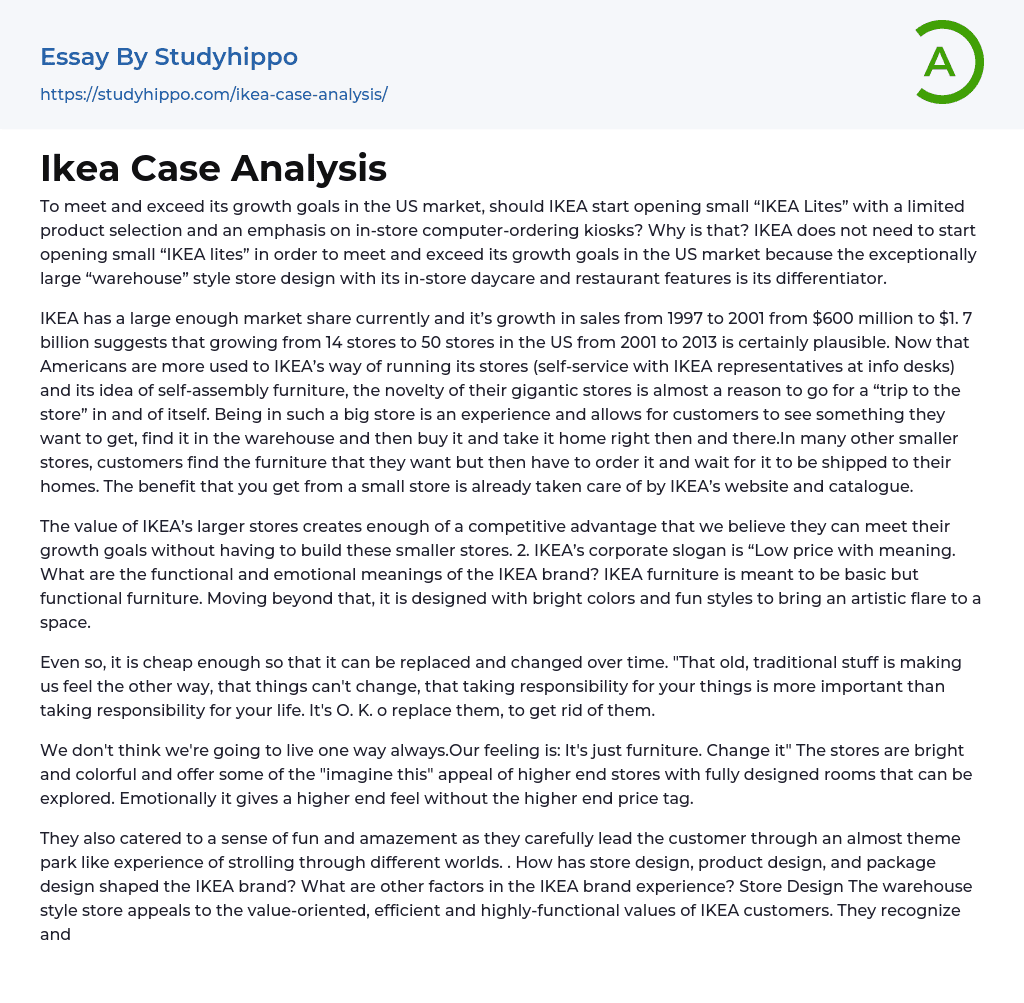Is it advantageous for IKEA to establish "IKEA Lites" in the US market that offer a limited product range and computer-based ordering kiosks within the store to achieve its expansion objectives? However, this might not be necessary as IKEA's unique selling proposition is its huge "warehouse" format store layout that includes on-premises childcare and dining amenities, setting it apart from rivals.
The fact that IKEA's sales grew from $600 million to $1.7 billion between 1997 and 2001 indicates that the company already holds a substantial market share. Consequently, their plan to expand from 14 stores to 50 in the United States between 2001 and 2013 seems attainable. American consumers have become familiar with IKEA's store layout, which involves self-service shopping with representatives available at information desks, as well as the idea of self-assembled furniture. The size of IKEA's stores ha
...s become an attraction in itself, offering customers a unique experience where they can explore the warehouse for desired items before purchasing them and taking them home on the spot. Unlike smaller establishments, customers do not need to wait for delivery after finding what they want; instead, they can buy it immediately and leave with their purchase. Additionally, IKEA's website and catalogue address any advantages small shops may offer.
The larger stores of IKEA provide a sufficient competitive advantage for them to reach their expansion targets without constructing smaller stores. Furthermore, the functional and emotional implications of the IKEA brand slogan, "Low price with meaning," are evident in the basic yet practical designs of their furniture and the incorporation of lively colors and playful styles aimed at adding an artistic touch to any space.
Despite being inexpensive, it ca
still be replaced or changed in due course. The old-fashioned objects can hinder progress by instilling a sense of being stuck and discourage taking responsibility for life rather than possessions. Therefore, it is acceptable to dispose of them and upgrade to better options.
The belief is that living one way forever is unlikely. The mindset is that furniture is easily replaceable. The retail stores are eye-catching with vibrant colors and a "what if" allure similar to upscale stores displaying complete room setups for customers to browse. It creates a high-class atmosphere without the expensive price point.
By combining store design, product design, and package design, IKEA creates a unique brand experience. One crucial element of this experience is the feeling of excitement and wonder that customers experience as they navigate through various themed areas similar to a theme park. The warehouse-style layout appeals to the practical and cost-conscious values of IKEA shoppers while also catering to their indirect needs with features such as on-site childcare and a restaurant. As a result, shopping at IKEA becomes more than just a chore; it transforms into an enjoyable "experience."
The product design created a new segment in the American Furniture market, emphasizing on functional furniture with a vast range and high frequency of in-home turnover. The consumers were urged to evaluate and purchase for their immediate needs, and later buy again after 3-5 years when their requirements change. Consequently, they transformed furniture from an investment model to a consumption model, which facilitates increased sales volume. The flat package design not only increases the product range and capacity that IKEA can offer and store on-site but also enables
the company to streamline its production and operations process, lower consumer costs, and promote a distinct culture.
The shopping experience at IKEA is just as captivating as the merchandise. Visitors are invited to leisurely peruse the furniture-themed amusement park and gain ideas on incorporating budget-friendly, highly functional stylish pieces into their living spaces.
- Wal-Mart essays
- Discover essays
- Advertisement essays
- Advertising essays
- Anheuser-busch essays
- Audience Theory essays
- Brand essays
- Brands essays
- Competitor Analysis essays
- Consumer essays
- Detergent essays
- Marketing Management essays
- Marketing Mix essays
- Marketing Plan essays
- Marketing Research essays
- Marketing Strategy essays
- New Product Development essays
- Point Of Sale essays
- Price essays
- Procurement essays
- Product essays
- Product Differentiation essays
- Product Placement essays
- Promotion essays
- Promotion And Marketing Communications essays
- Research Design essays
- Retailing essays
- Trademark essays
- Adidas essays
- Amazon essays
- Apple essays
- Bmw essays
- British Airways essays
- Burger King essays
- Coca-Cola essays
- Company essays
- Costco essays
- Dell essays
- Ebay essays
- Enron essays
- Facebook essays
- Ford Motor Company essays
- Gap essays
- General Motors essays
- Google essays
- Honda essays
- Ibm essays
- Ikea essays
- Intel essays
- Iphone essays




